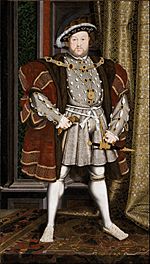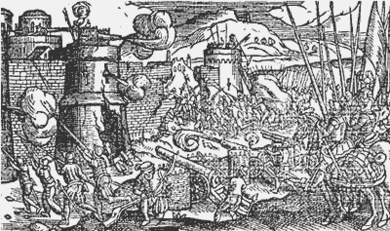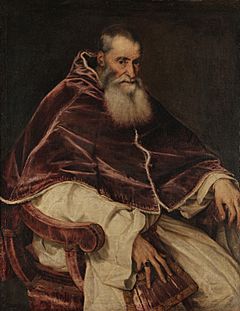Charles Reynolds (cleric) facts for kids
Quick facts for kids The Venerable Charles Reynolds BCL |
|
|---|---|
| Archdeacon of Kells | |
| Native name | Cathal Mac Raghnaill |
| Diocese | Meath |
| Appointed | 13 February 1532 |
| Predecessor | John Treguran |
| Successor | Thomas Lockwood |
| Other posts | Rector of Nobber |
| Orders | |
| Rank | Archdeacon, Bishop-elect |
| Personal details | |
| Birth name | Cathal Mac Raghnaill |
| Born | c. 1496 Mohill, county Leitrim, Ireland |
| Died | 15 July 1535 (aged 38–39) Rome, Kingdom of Italy |
| Buried | Archbasilica of St. John Lateran, Rome |
| Nationality | Irish |
| Denomination | Roman Catholic |
| Residence | Mohill, later Maynooth |
| Parents | Marus Mac Raghnaill |
| Previous post | Canon at Priory of Mohill |
| Education | Canon law |
| Alma mater | University of Oxford |
Charles Reynolds (in Irish: Cathal Mac Raghnaill) was an important Irish Catholic church leader. He was born around 1496 and died in July 1535. He was known for his knowledge of church law and for helping to manage church areas.
Charles Reynolds was born in County Leitrim, Ireland. He came from a well-known family. He became an archdeacon, a senior church official, and served as a chaplain to the powerful Earl of Kildare. Even though his Irish name was Cathal Mac Raghnaill, he used the English name Charles Reynolds. This helped him get important church jobs under English laws. He studied at the University of Oxford and could speak English, Irish, and Latin.
Reynolds strongly disagreed with King Henry VIII of England's decision to break away from the Catholic Church. He refused to accept the King as the head of the Church in England. He also did not agree with the King's decision to end his marriage to Catherine of Aragon.
During the Kildare Rebellion (1534–1535) against King Henry, Reynolds was sent to Rome. His mission was to ask the Pope for help. In May 1535, he succeeded in getting the Pope to promise to excommunicate (officially remove from the church) King Henry of England.
Charles Reynolds sadly died in Rome in July 1535 from a serious illness. He was buried in the Archbasilica of St. John Lateran. His grave stone tells us about his life, including his birth and death dates. It also mentions that the Pope had planned to make him a bishop. After his death, he was accused of a serious crime against the King in 1536.
Contents
Who Was Charles Reynolds?
His Early Life and Education
Charles Reynolds was born in 1496 or 1497 in Mohill, a town in County Leitrim. At that time, Mohill was an important religious center. His father, Maurus Mac Raghnaill, was a church official called a canon. Charles learned Latin from his parents before going to a school for noble children.
When he was about fifteen, Charles became a novice at the Augustinian Priory of Saint Mary. This was a monastery belonging to the Canons regular of St. Augustine, a group of religious people. The Mac Raghnaill family had strong ties to this monastery for many years.
We don't know much about his very early life or his first church duties. But Charles must have been highly respected. After finishing his training in Mohill, he moved to the more important Diocese of Meath. In 1528, he was studying Canon law (church law) at the University of Oxford. This was a special chance for an Irishman at that time. His family, the Mac Raghnaills, were allies of the powerful Kildare family. This connection might have helped him get special treatment from the church.
Charles Reynolds finished his law studies around 1531. He then received a special permission called "English liberty." This allowed him to own property and take on church roles in areas of Ireland controlled by the English.
Becoming an Important Church Leader
When Charles Reynolds returned to Ireland, he became a chaplain to Gerald FitzGerald, 9th Earl of Kildare. The Earl of Kildare was the most powerful person in Ireland at the time. On February 13, 1532, Reynolds was also appointed as the Archdeacon of Kells and rector of Nobber.
As an expert in church law, he was very active in managing church affairs in his area. These appointments happened during a time of huge changes around the world. It was also a dangerous time for the Christian church. Reynolds soon became involved in major political events.
Standing Up to King Henry VIII
By 1533, there was a lot of tension in Ireland and England. This was because of King Henry VIII's English Reformation, which was changing the church. In Ireland, the English government was mainly controlled by rival Irish-Norman groups. Only a few English church leaders were trusted to support the King's changes in Ireland.
Rumors spread that Charles V, Holy Roman Emperor, who was upset about how King Henry treated his aunt, Catherine of Aragon, might get involved in Ireland. King Henry's chief advisor, Thomas Cromwell, decided to send an Englishman, William Skeffington, to govern Ireland. The current governor, Gerald Fitzgerald, was put in the Tower of London in 1534. This made his son, Silken Thomas, start the "Kildare rebellion." Other countries started to pay attention to Ireland because there was a chance of a military conflict.
Charles Reynolds was a key member of a group of Irish church leaders who spoke out against King Henry. They believed the King was going against church teachings. These leaders thought that English rule in Ireland was only allowed by the Pope's approval. They felt that if the King rejected the Pope's authority, then his rule in Ireland was no longer valid.
The rebellion faced difficulties, especially when Archbishop John Alen, who supported the King, died during the conflict. The Pope then officially removed Silken Thomas from the church.
Reynolds was sent abroad to seek help against King Henry VIII. He left Ireland by boat in December 1534. First, he visited James V of Scotland, who was not very friendly with Henry VIII. Reynolds received encouragement and a letter from James V. Reynolds then traveled to Spain and met with Charles V. He was promised military help, but this help never arrived. Finally, Reynolds went to Italy and arrived in May 1535. There, he personally presented his case to the Pope.
Meeting the Pope
When Charles Reynolds met Pope Paul III, he strongly criticized the Pope for not condemning King Henry's actions. He said he represented the Earl of Kildare, other Irish nobles, and their allies in England. Reynolds argued against King Henry's church policies. He said the Pope had been careless by delaying a decision about Henry's marriage. He believed that if the Pope had already removed Henry from the church, the English people would have rebelled and made sure the Pope's decision was followed.
To support his points, Reynolds showed the Pope copies of King Henry's printed writings and a copy of an old document. This document was from Pope Innocent III to King John of England, which supported the idea that Ireland was under the Pope's authority. Reynolds also asked the Pope to forgive Silken Thomas for the death of Archbishop Alen. He claimed that Alen had supported the King's new church policies and had planned to harm the Earls of Kildare.
Pedro Ortiz, who was Charles V's ambassador in Rome, wrote down what happened at the meeting. According to Ortiz, Pope Paul III was impressed by Reynolds' arguments. The Pope forgave the Earl, apologized for past delays, and promised to remove King Henry VIII from the church.
Death and Legacy
Charles Reynolds never left Rome. He became very ill with a fever, possibly malaria, and died in early July 1535. He passed away just one day before the Pope was going to make him a Bishop. Reynolds was buried in the Archbasilica of St. John Lateran in Rome on July 15, 1535.
His Impact
On August 30, 1535, Pope Paul III prepared an official document to remove King Henry from the church. Later, on December 17, 1538, the Pope issued another document. This one renewed the earlier decision, which had been put on hold because the Pope hoped Henry would change his mind.
If Reynolds had not died and had returned to Ireland, he would have been arrested and possibly executed. This is because a law passed in 1536 accused him, Silken Thomas, and others of a serious crime against the King. Reynolds' property was taken by the King.
His Grave in Rome
Reynolds' grave stone is in the cloister (a covered walkway) of the Basilica of St. John Lateran. It is still on display there. The stone is damaged on its sides, but most of the writing is still clear. This inscription helps us understand more about what happened to him. It is a large stone, about 1.42 meters (4.6 feet) tall and 0.62 meters (2 feet) wide. The top part of the stone is missing, but you can still see parts of the Fitzgerald family crest and the symbol of the Reynolds family.
The writing on the grave stone tells us that he was buried on July 15, 1535, and was thirty-eight years old. It also says he died the day before he was supposed to become the Bishop of Elphin and Clonmacnoise. The inscription praises his memory and states that he was an Irishman from a noble family. It also mentions he was skilled in both civil and church law. Charles belonged to the Mac Raghnaills, a Gaelic family from southern County Leitrim. The stone names his father as Maurus Mac Raghnaill, a canon at the Augustinian Priory in Mohill.
See also
Images for kids








